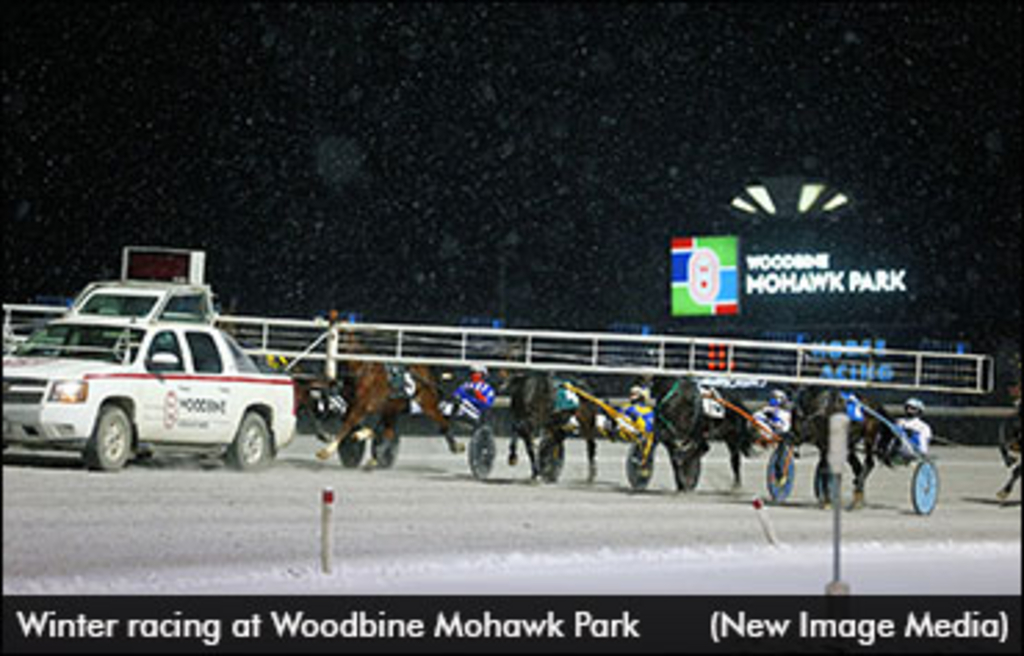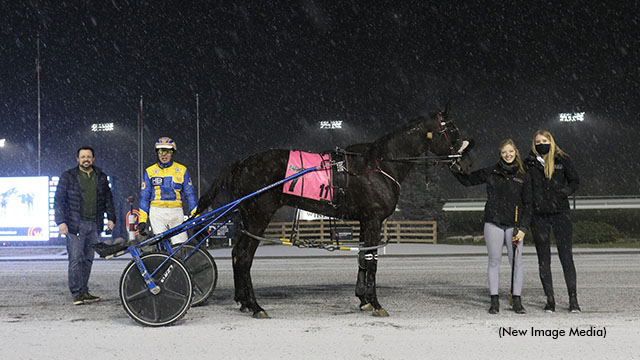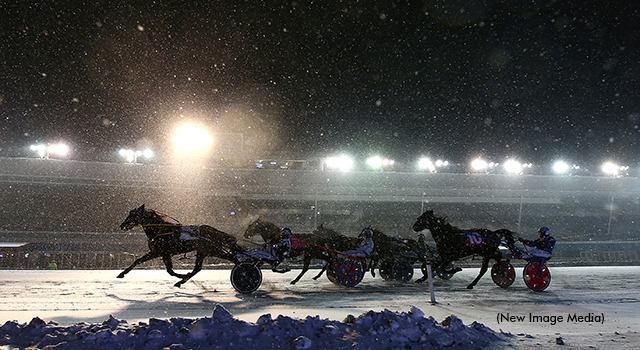
When it comes to weathering the cold months in Standardbred racing, practices put in place from all participants may differ, but the end game is always the same.
As the temperatures continue to drop and winter weather descends upon Woodbine Mohawk Park and surrounding areas in southwestern Ontario, those connected to the Standardbreds are prepared to go the extra mile to ensure the safety and welfare of the horses.
Whatever winter has in store – wind, snow, sleet or otherwise – horses can withstand colder weather more so than humans, as they are more equipped to maintain their body temperatures in freezing temperatures. A horse’s coat acts as a water repellent and their guttural pouches, found at the back of the throat, warm up the air before it reaches the delicate tissues of the lungs. Horses rarely get frostbite, but the most likely spot for it to occur is the tip of the ears.
“You don’t change a whole lot prior to warming the horses up,” said Michelle Olson, a longtime groom, who recently earned her trainer’s license. “Post warm-up on the track, it’s more of a challenge to keep the horses warmer between races. Some nights, depending on just how cold it is, you might need two coolers [blankets] to make sure they are kept warm. The whole concept, really, is to keep the horses as comfortable as possible.”
Other notable safety practices during winter racing include ensuring a horse’s tongue isn’t tied outside the mouth as the tongue is susceptible to freezing and increasing hay portioning on cold days to aid in the horse maintaining its weight. Horses use more energy in the winter as they generate body heat through the digesting of plant fibres.
Olson, who has worked as a groom at Woodbine and Mohawk since 2010, is well versed in the extra care horses need over the winter.
Two important requirements centre on water, albeit in differing ways.
Providing a horse with lukewarm water during the winter encourages water intake, as horses will be reluctant to drink ice-cold water, which could leave them dehydrated and increases the chances of impaction colic.
“A huge thing is to keep them drinking water,” noted Olson, who typically takes care of two to three horses on a racing night. “In winter, they will naturally slow down their drinking. Once they are on a program, and I’m speaking of my own, they will drink the amount of water they need to all-year round. I have two buckets in my stall all-year round. Making sure they are well hydrated, whether that’s in the winter or summer, is a must.”
Using less water when bathing a horse will help to dry the horse more quickly, while the addition of some rubbing alcohol to the bathwater will expedite the drying time. It’s also imperative to keep the horse away from direct drafts when it’s cooling down as respiratory problems can occur when a horse gets chilled after exercising. A horse is fully cooled down when the coat is thoroughly dry. While it’s important to protect a horse from direct drafts, it’s equally key to open trailer vents to enable fresh air to flow throughout the trailer.
“In the summer, you will see a lot of horses being bathed between trips and racing,” said Olson. “That isn’t as common in the winter. It’s really about keeping the horse dry. When they come back from racing, you make sure that they are cleaned off – if the track is muddy – and get them dried as quickly as possible. In the summer, you tend not to throw a cooler on them as soon as they come back from a race, whereas in the winter you would tend to do that more quickly so that they aren’t getting cold too quickly.”

on Saturday, Nov. 27 at Woodbine Mohawk Park. (New Image Media)
One huge benefit at this time of the season, noted Olson, is the ability to go about her craft in the Woodbine Mohawk Park paddock.
“It’s very warm in the paddock, so we’re fortunate because nothing drastic really needs to be done. I think the bottom line is everyone working together so that everyone is safe out there.”
That would include the racetrack itself.
“Before year-round racing at Mohawk started, several winterizing projects took place to ensure racing could be conducted safely and comfortably during the colder months,” said Megan Walker, Senior Manager, Racing Operations, Woodbine Mohawk Park. “They included new doors, air curtains and heaters – among many other things – to help keep drafts out of the paddock. In extreme weather, post parades are shortened to help limit the time horses and drivers are on the track. The track crew also plays a huge role in keeping everyone safe on the track during the winter months.”
When the pacers and trotters head out to the racetrack, the commitment to horse safety continues.
Warming up horses properly, pre-race, helps prevent leg and muscle injuries.
Scott Young, a fixture at Woodbine Mohawk Park, endeavors to keep each horse he’s driving in perpetual motion ahead of the race.
“It does depend on each horse and the time you have before you line up for the race, but you can jog the horse for one lap and then walk them, time permitting,” said the lifetime winner of more than 1,100 races. “I just try to keep my horses moving in the winter. It doesn’t have to be fast, but you want to keep them moving.”
Ahead of the races, Young makes sure he’s dressed for cold-weather success.
“Physically, I prepare based on just how cold it is. On the really cold nights, you wear lots of thermal gear. The way the races are run, they don’t have us on the track for too long, typically, one lap and then go to the gate, which is nice. As long as you’re not out there too long with the adrenaline going, you do manage to stay pretty warm. We do have our winter suits, our puff suits, that are very well-padded inside. We do have mud tops and mud pants in case we need them. You make sure your driving glasses are clean and get ready to get prepared for the next one. Really, it’s all about dressing for the occasion.”
Despite the challenges of racing during the colder months, there are moments, albeit few, when Young takes everything in stride.
“When it’s not too cold out and the snow is falling, it’s a pretty cool look. It happened recently at Mohawk where we had this random snow cloud pass by and when we left the gate – you know when you drive your car in the snow and you put your high beams on and it looks pretty cool coming at your window – it started to do that. It was like the snow was blowing around us, kind of like a snow globe.”

Regardless of what the forecast calls for over the next few months, keeping the horses safe is the top priority.
“These horses are amazing athletes,” praised Young. “You realize that every time you sit in the race bike. A lot of care goes into the well-being of the horses, and everyone plays a part in that.”
(Woodbine)

